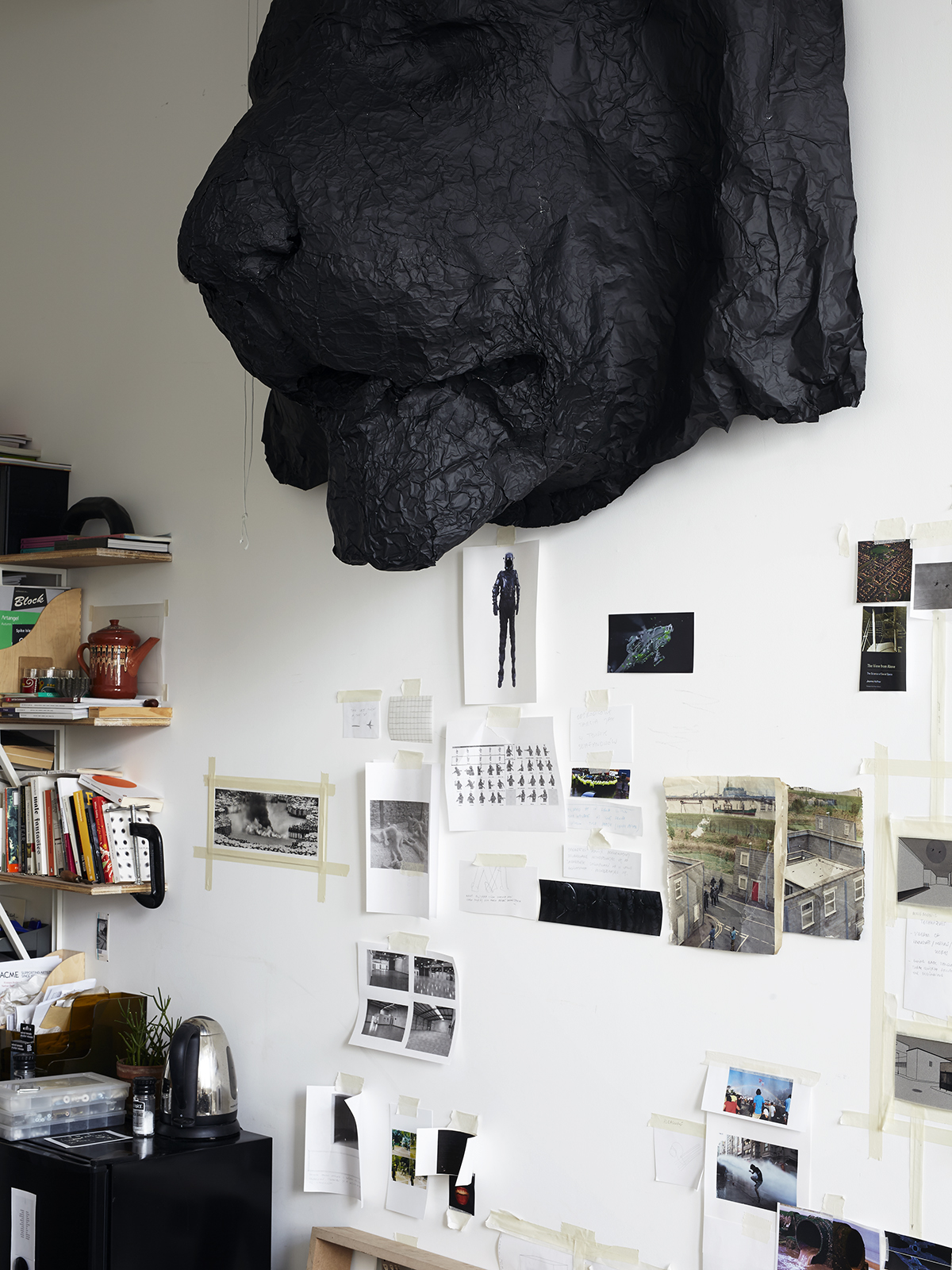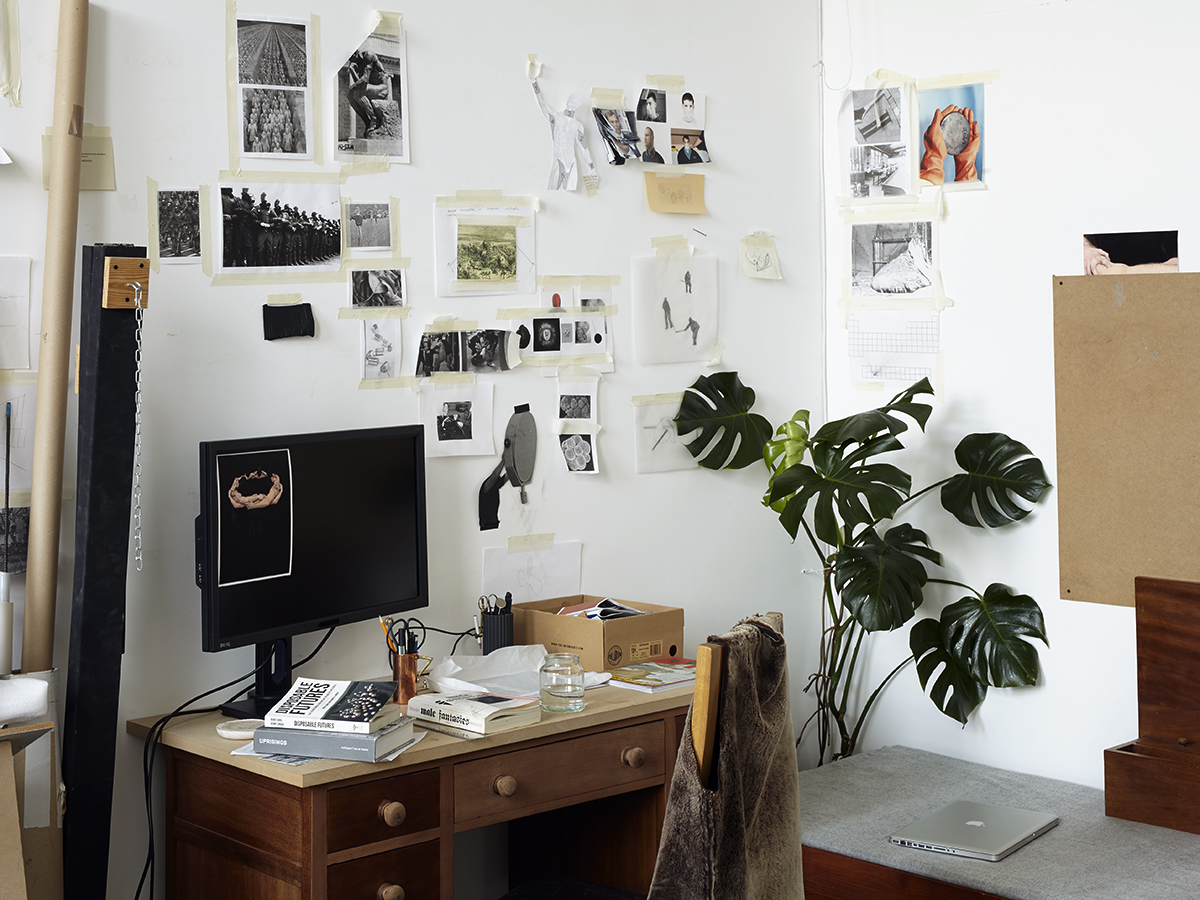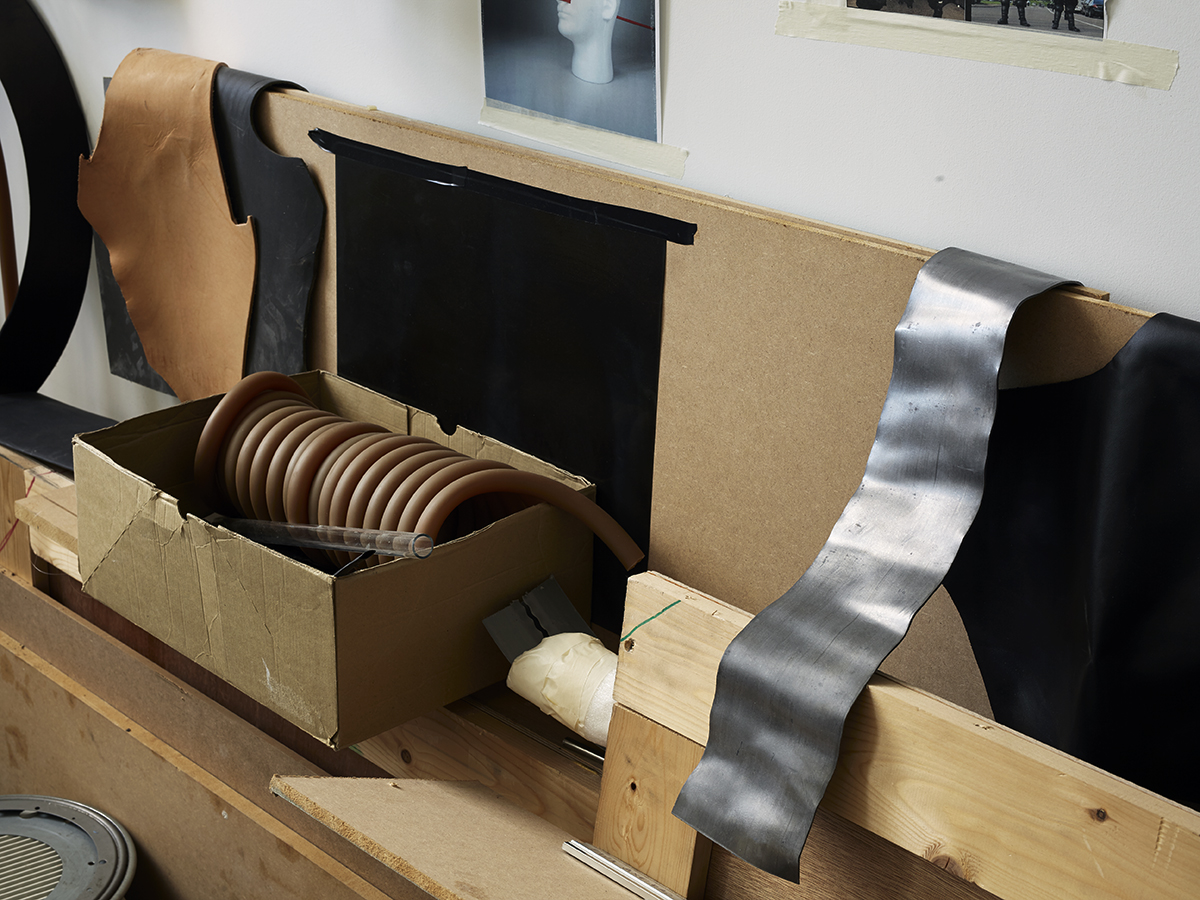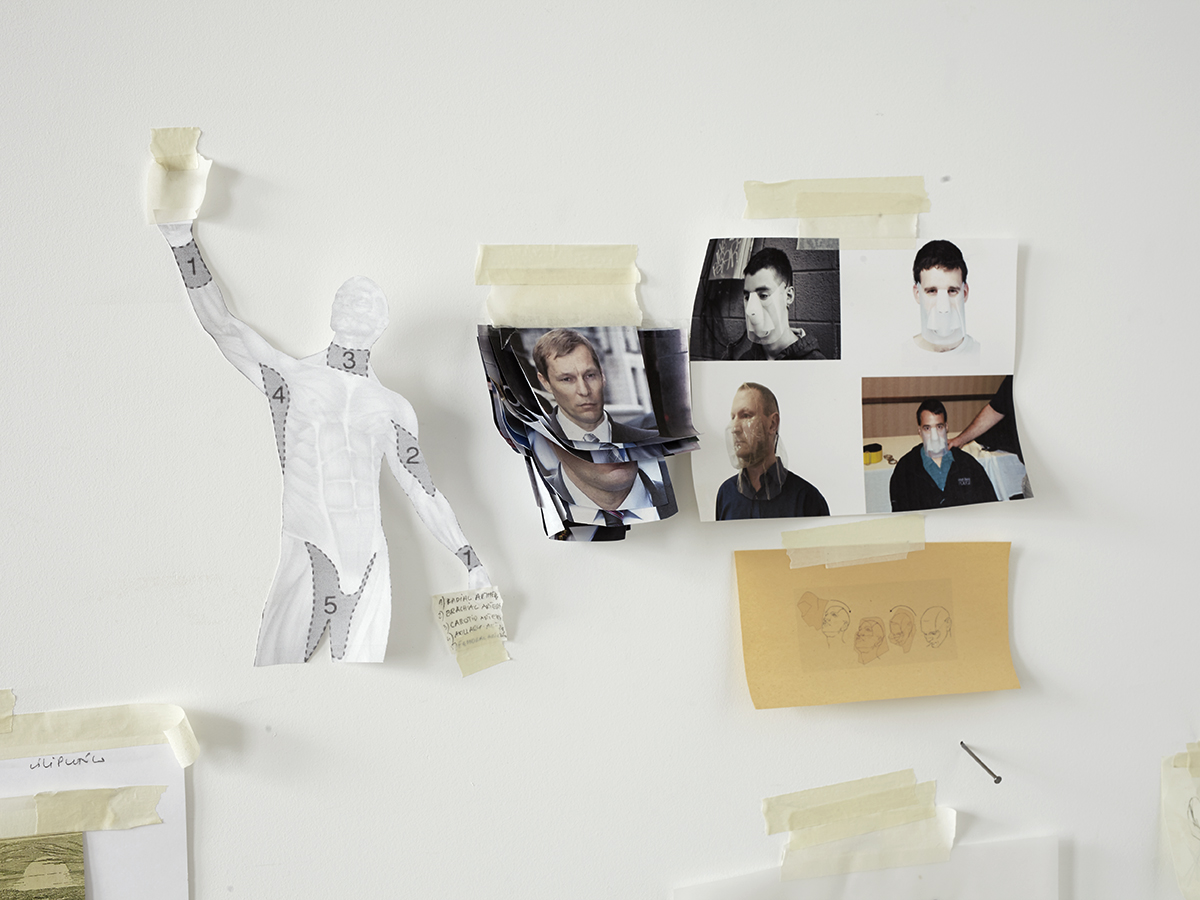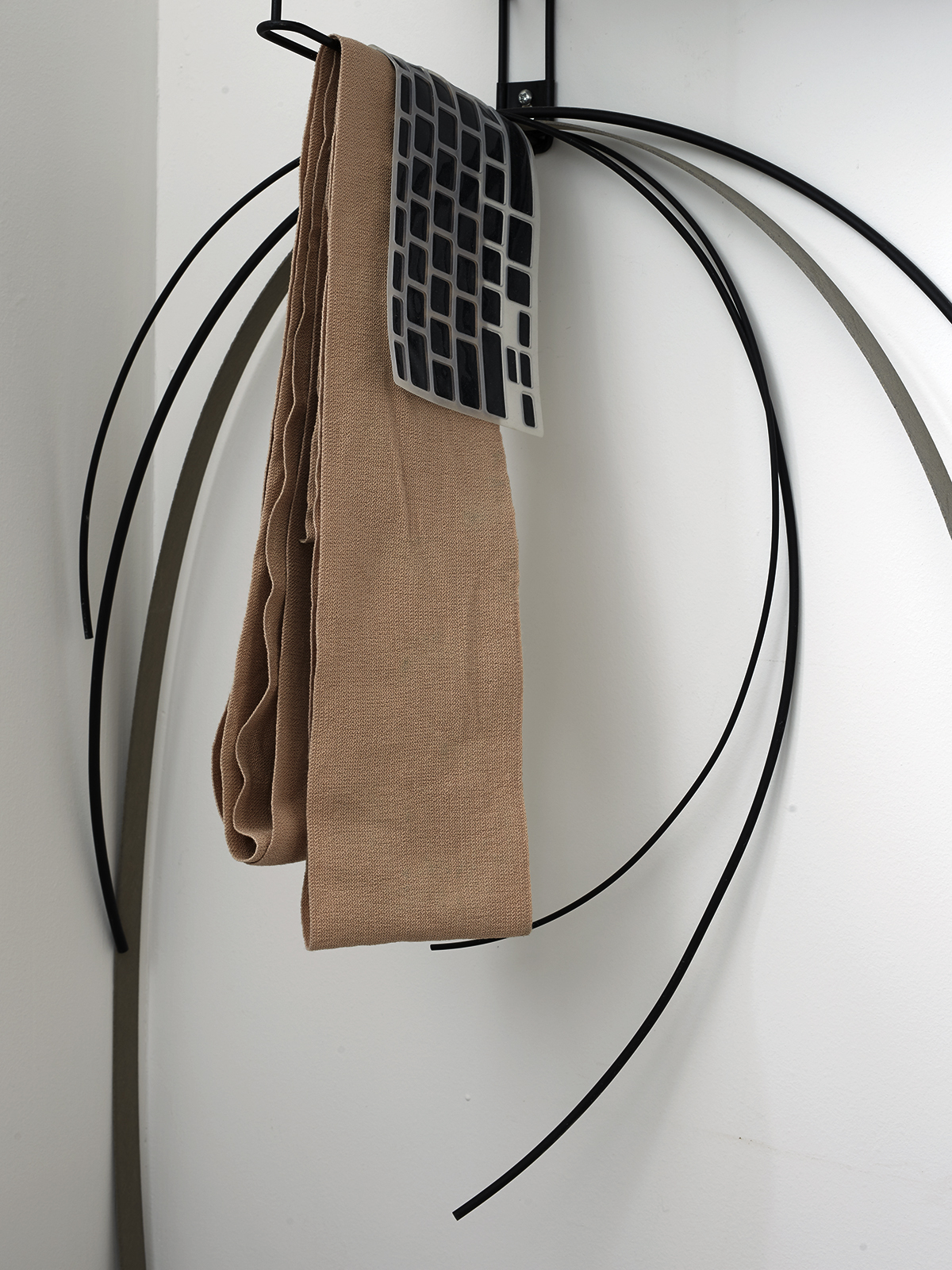
On my way to Axelrad’s studio, I think about the fact that London bus drivers wave to each other when they pass one another. That isn’t strange, but—and I have been observing this for some time—they will only greet drivers of the same bus route: the 488, bound for Bow will raise a hand and nod to a fellow 488, but not to an 8 headed to Tottenham Court Road.
It’s a very peculiar human quality that makes us want to stand out and fit in at the same time. We’re drawn to one another by identification: same profession, same hobbies, same clothes, same neighbourhood. Groups tend to look like one another, unless they’re a group of people who are attracted to each other because they all don’t want to look the same. Which is the same thing. How problematic does that become when we prejudice our bonds based on religion or skin colour? Even babies, proclaimed the University of Texas, group together with those they consider to be “like them”.
This disturbing phenomenon of human behaviour was demonstrated when Channel 4 attempted a new survival-type reality TV show. The show was canned in 2016 after just four episodes because it got, producers said, “quite dark”. (Think, the real life Lord of the Flies, but with added misogyny). Only ten of the original twenty-three made it through the whole year on a remote Scottish island, and in their behaviour was perhaps not very surprising. As one participant said, in a new documentary released last week about the failed social experiment: “We’re here to find out who we really are.”
Ewa Axelrad introduced me to Eden during our studio visit. It’s just the kind of socio-psychological experiment that delves into the brute tribalism she likes to think about in her work. Her most recent exhibition in Poland—coming very soon to Copperfield, London—for example, explores our desire to be part of the herd, patriotism, paramilitary organizations, and how it can all tip into violence in the guise of good.
When she comes to the door of her studio in Stratford, it’s a surprise to later hear that the artist has experienced the malaise of not quite fitting in: she’s warm, funny and easy to be around. Her work is too: my eyes fall on a sculpted black Puffa jacket, in an ape-like pose, an enlarged bum-hole shape where a head is expected to protrude.
Dangling on a wall like a fetish dungeon are certain materials she’s waiting to work with: stab-proof police gear, surgical latex tubing for medical colonic irrigation (bought on eBay), vinyl lead for x-ray protective clothing. Her works are undeniably sexy—but something psychopathic almost certainly lurks beneath.
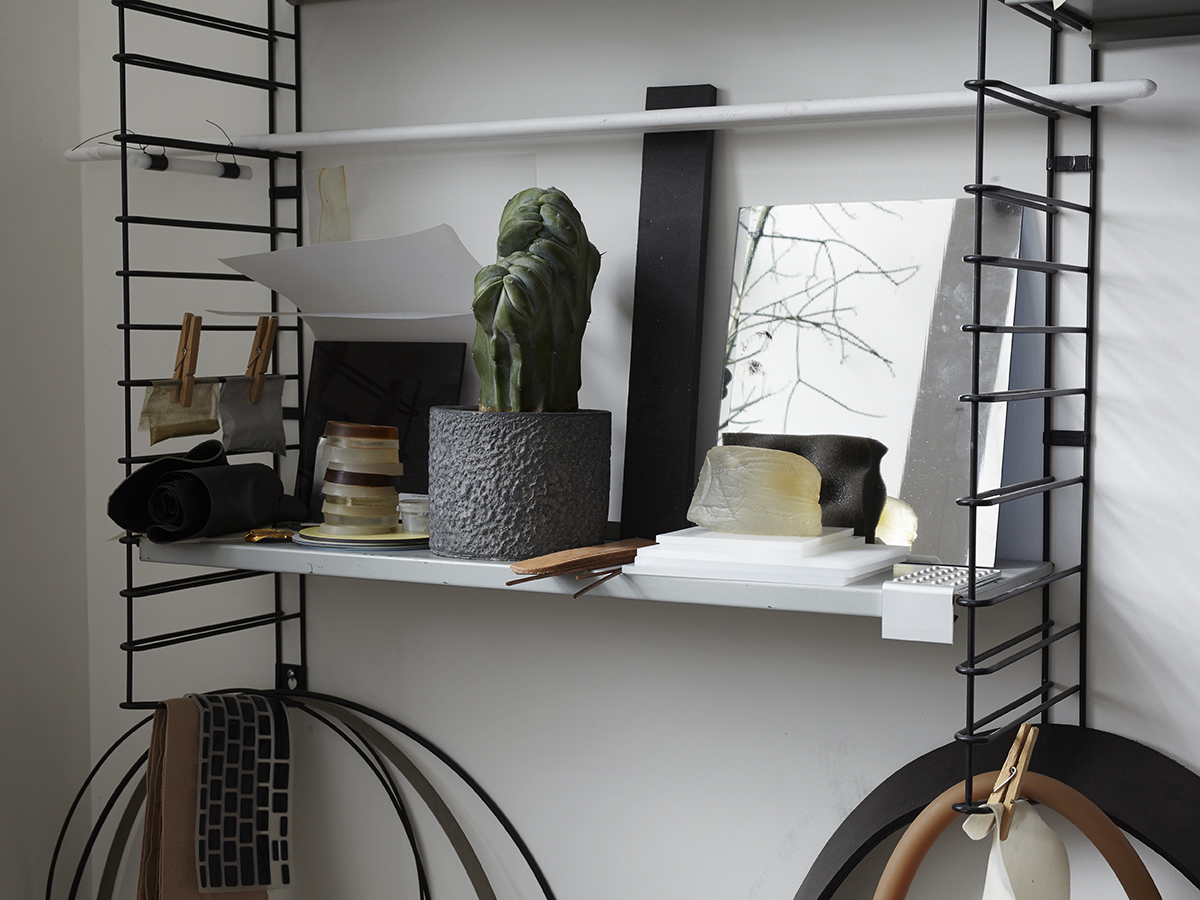
Your exhibition, Shtamah, has just been shown in Poland, at the Wrocław Contemporary Museum, and will be coming to London next month. How have current events there impacted on your thoughts for this show?
It was important to me that it was shown in Poland first because the project is very much informed by the recent rise in far-right nationalism under the current Polish government. You see the longing for a mythologized idea of fighting for your country and paramilitary groups popping up everywhere. Some years ago I was captivated by Klaus Theweleit’s Male Fantasies, I looked into it again recently and it was striking to see the similarities between these current formations and Freikorps that Theleweit studied. Freikorps were German paramilitary units formed by native volunteers, enemy renegades, deserters, criminals etc. They were particularly present before WW2 and essentially were precursors to Nazis. It’s impossible not to draw parallels with self-organized groups that we see now… I’m very interested in this desire for combat and fetishization of warriors, I think countries or members of societies that are not currently involved in any local military conflict are particularly prone to share these fantasies, you have just the glorified warrior without the tragedy of real war.
In Shtamah you’re focused more on unsanctioned paramilitary organizations, but you’re interested in all kinds of legitimized groups that run on similar ideas too?
Certainly, army and police have also been something I’ve been looking at. Their character is fluid, it changes not only depending on time and political system but also varies from country to country. Take for example the US and the UK: even on a linguistic level, in the UK you say “I’m a policeman/policewoman”, whereas in the US you say “I’m the police”. It gives you a very different sense of your role and responsibilities within this structure. In Shtamah I’m looking at this powerful transformation one undergoes when they’re part of a larger body.
How has the Polish patriotism that informed Shtamah affected you?
I always took it for granted that at school one studies large portions of patriotic literature, that was my experience and I never questioned it. My grandfather mentioned to me recently the omnipresence of patriotic poetry at every post office, kiosk, grocery shop etc. Out of research-oriented curiosity, I asked him to send me a copy. I opened this cheesy-looking book and with a critical distance started reading. Minutes later I found myself with tears in my eyes, completely overwhelmed by this powerful poetry that I was fed as a child. I obviously must have found it very powerful as a young girl, probably even believed this brainwashing narrative that “there is nothing sweeter than dying for your country”. It just all came back, completely possessed me, how ridiculous is that! And I didn’t grow up at a home that nurtures this narrative so just think how powerful it must be for many others that absorb it from everywhere around, it’s really disturbing.
What do you think has made you so interested in this subject?
I grew up near to a military training ground, so I always saw soldiers around. But also talking to my Grandfather, who is a bit of a paradox; an ex-army colonel and a doctor. For him, joining the army was the only way to study medicine–at the Military Academy of Medicine. So at heart, he’s a pacifist but at the same time, he stayed within the army structure for a very long time so from a young age I always heard stories he told me. This conflicted picture really resonates with me. I was always naturally attracted to the military uniform and iconography. This attraction is still within me and I can’t deny it. But it is in conflict with the cognitive criticism within me and I find this tension stimulating.
There’re also aspects of violence, sexuality and gender that linger in your works and that’s very present in the groups you talk about.
Yes, I think they are inextricable. Combat is still perceived by many as part of the transition from boyhood to manhood, so sexuality is written into it. The whole bravado, the posturing, muscle flexing, the way they walk–it’s very primal, perhaps having something to do with sexual selection?
You don’t give a straightforward critique at all, is that important?
Really important. I’m not into simple answers, there are no simple answers. But I need to anchor myself somewhere; I need to ask myself questions to get to the core of what is it that specifically draws me to each subject, where do I stand within it, why does it pester me, I think it’s the only way to stay true to myself. I have a thing for psychological studies, they’re always complex, never one-dimensional and in a way what I’m trying to do in my work is to build a situation where as a viewer you experience this complexity, where you can identify with many different emotions. This is also where aesthetics plays a huge part.
Apart from that, the process of developing a project is a way of learning for me. I start with one dot and another one, I feel they are somehow connected and I’m trying to understand that connection.
Do you feel a certain responsibility to dig deep psychologically, in that way, to understand your motives?
Totally. Often I question my right to talk about certain subjects, especially if I feel that I’m looking at them only from the outside. I’m not always in the very middle of every situation so I need to clarify to myself whether I’m talking about, with or to it. There are loads of subjects I want to explore but there has to be a personal “in” for me. Like in Shtamah; I know all too well the desire to be part of a group or a larger body but also the feeling of inaccessibility, of being bullied.
This sense that things may always change, neighbours can turn into aggressors, that the current state of things can’t be taken for granted has certainly had an impact on me and informs my practice.
On that, can we talk about this puffa jacket sculpture that is crouched here next to us? It looks both violent and vulnerable. I also love the anus where the head should be.
The anus indeed does look like it’s going to spray you! I like having it here, it’s the first sculpture I made in this studio. It’s called Anomalia (2015) and you’re right, there is a tension between power and vulnerability to it. This piece started a body of work Minimum, Necessary, Objectively Reasonable (2015-2016). The term comes from American policing, after a number of cases where the police were using excessive force so under pressure from the public they coined this phrase as an attempt to define what kind of force can be used. Words, however, don’t change the fact that a lot of the times “taking someone down” resembles a social spectacle. Having several people jumping on an unarmed man sends a message to the public that he/she’s some sort of wild beast needing to be pacified in the name of public order. So Anomalia made me look more into biopolitics.
I can see how that also relates to some of the other sculptures you made for that series.
I wanted to look at actions gone wrong, the grey area with room for violation and how some abuse their position of public trust or do one thing in the name of another, so I did a number of sculptures on this idea, such as the hands in the cardiac massage position (Minimum, Necessary, Objectively Reasonable #1, 2015), they are made out of concrete and stacked on top of each other looking as though they could do more harm than good.
And what about this giant lion head on the wall? I recognize that from your recent group show at Copperfield, and your Bold Tendencies commission Let’s go. Yes, let’s go. (They do not move) in Peckham.
It’s made out of cine-foil–thin black aluminum foil used mainly in film and theatre industries which behave a bit like a chocolate wrapping in a sense that it takes the form of whatever you place it on. I wanted to work with it for a long time but there wasn’t a good reason to use it. And then last autumn Hannah Barry and Diana Cordoba Barrios invited me to do a commission for Bold Tendencies’s rooftop. I was really drawn to the thinness and tired look of the crumpled cine-foil, from afar the sculpture looks heavy and solid but when you come close you can see it’s very fragile, when it rains or it’s really windy you can hear the percussive sound it makes.
So how did you make those?
Well, that was a right challenge! There was a whole team working on it, they were really amazing. We had a Trafalgar Square lion 3D scanned, then CNC-ed for us and brought to the car park for us to take impressions of it in cine-foil. Then there were elements like the sandbag barricade, for them we made a real concrete sandbag wall on a lower level of the carpark and were taking impressions of it. The lion’s head you see on my wall is very thin and delicate but the installation at Bold Tendencies had to be strengthened from the inside just enough not to blow away but also not too much so that we keep the fragile sense of it, a difficult balance to strike. We used a crazy amount of cine-foil, absolutely mad! So everything was planned for months and made on site, for three to four weeks the car park was our studio.
Why Trafalgar Square?
Dynamics of riots has been a subject of my work for some time now. Several years back when I was a student at the RCA I got into a conversation with Richard Wentworth about urban planning and about London’s lack of a main square–you know, when people protest they always gather in the main square–and Richard mentioned how even Trafalgar Square, which is considered a sort of a main square and protests do take place there, has been broken up by steps and how this disrupts the natural flow of masses. So his 2015 Bold Tendencies commission Agora reminded me of the chat we had and that’s how I decided to transplant this protest place to Peckham’s rooftop, take the lions down from plinths and create a Maidan-like post-battle ruin-like surreal landscape. The somewhat dystopian feel of this work comes from my sense of disillusion with the power of protests and questions about their ability to bring change. But now in the summer months when the installation is filled with people sitting around it with drinks from Frank’s Cafe it brings to mind questions about the protest as a form of entertainment, a spectacle, so I felt borrowing a title from a theatre play was appropriate.
Ewa Axelrad, Shtamah, opens on 20 September at Copperfield, London, and runs to 18 November. Photographs © Tim Smyth
